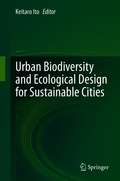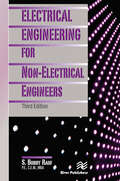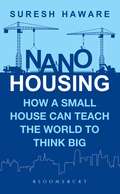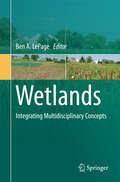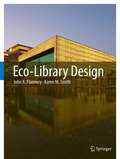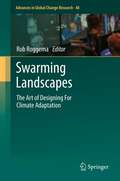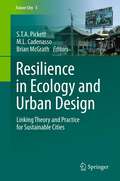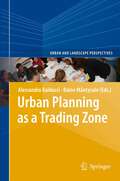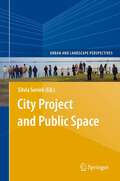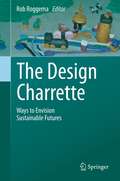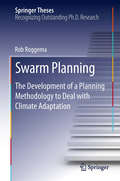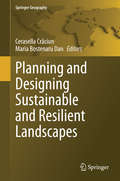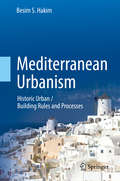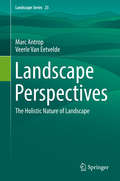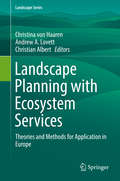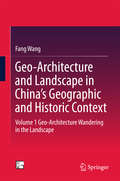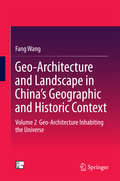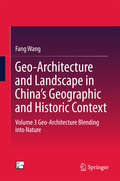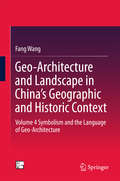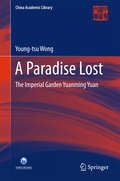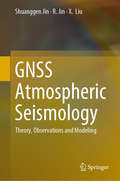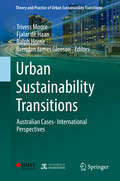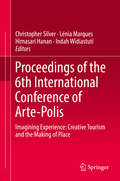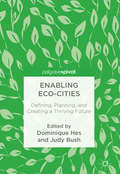- Table View
- List View
Urban Biodiversity and Ecological Design for Sustainable Cities
by Keitaro ItoThis book highlights various designs for urban green spaces and their functions. It provides an interesting meeting point between Asian, European and North America specialists (researchers, planners, landscape architects) studying urban biodiversity; urban biodiversity and green space; relations between people and biodiversity. The most important feature of this book is the unique point of view from each contributor towards “the relationship between nature and people in urban areas”, in the context of the ecosystem and biodiversity in urban areas and how to manage them. All chapters explore and consider the relationship between humans and nature in cities, a subject which is taking on increasing importance as new cities are conceptualized and planned. These discussion and examples would be useful for urban ecology researchers, biologists, city planners, government staff working in city planning, architects, landscape architects, and university instructors. This book can also be used as a textbook for undergraduate and postgraduate city planning, architecture or landscape architecture courses.
Electrical Engineering for Non-Electrical Engineers
by S. Bobby RaufEngineers and non-engineers often eschew electrical engineering because it is premised on concepts and mathematical techniques that are somewhat more abstract and elusive than those employed in disciplines like civil, mechanical, and industrial engineering. Yet, because of the ubiquitous nature of electrical and electronic equipment and devices, and the indispensable role electricity plays in various facets of lives, a basic understanding of electrical engineering is essential. Engineers and non-engineers find themselves interfacing with electrical apparatus and dealing with matters that permeate into the electrical realm. Therein lies the purpose and objective of this book. This edition includes numerous updated pictures, diagrams, tables, charts, graphs, and improved explanation of certain concepts.
Ecology, Cognition and Landscape: Linking Natural and Social Systems (Landscape Series #11)
by Almo FarinaIt is more and more evident that our living system is completely disturbed by human intrusion. Such intrusion affects the functioning of entire systems in ways we do not yet fully understand. We use paradigms such as the disturbance to cover large and deep gaps in our scienti?c knowledge. Human ecology is an uncertain terrain for anthropologists, geographers, and ecologists and rarely is expanded to include the social and economic realms. The integration of different disciplines and the application of their many paradigms to problems of environmental complexity remains a distant goal despite the many efforts that have been made to achieve it. Philosophical and semantic barriers are erected when such integration is pursued by pioneering scientists. Recently, evolutionary ecology has shown great interest in the spatial processes well described by the emerging discipline of landscape ecology. But this interest takes the form of pure curiosity or at worst, of skepticism toward the real capacity of landscape ecology to contribute to the advancement of ecological science. The past two centuries have been characterized by huge changes occurring in the entire ecosphere. Global changes are the effects of human intervention at a planetary scale, with consequent degradation of the environment creating an e- logical debt for future generations. On the other side of the issue, new technologies have improved the welfare of billions of people and have given hope to many other billions that they may also see such improvement in the near future.
Nano Housing: How a Small House Can Teach the World to Think BIG
by Suresh HawareThink big, act small… Act now… Many of us think big but fail to micro plan. Others get stuck at micro-planning, missing the 'big picture' of what impacts us nationally and globally. Housing is a basic necessity of human beings across the globe, and not just in India. Affordable housing for the masses is a key challenge for governments and policy makers. In Nano Housing, Dr Suresh Haware brings out a detailed study and offers solutions for the housing needs of India and its states and cities. A path-breaking and time-tested concept, nano housing is the outcome of an in-depth practical research which has the potential to fulfill the dream of the common man-an affordable house at an affordable price. Further, the book addresses the impact of GST, RERA and demonetisation on real estate; analyses REIT, home finance and rental housing; and voices the concern of homeless people, unauthorised housing, redevelopment and many other aspects of housing. An innovative and revolutionary idea, Nano Housing is a must-read for all businessmen in general and professionals, economists, sociologists, officials and policy makers engaged in the housing industry in particular.
Wetlands: Integrating Multidisciplinary Concepts
by Ben A. LePageThe science of wetlands and our understanding of these complex ecosystems have improved considerably. The emergence of multidisciplinary strategies is providing new opportunities and innovative approaches to address issues such as climate change and coastal protection. This book, with contributions from 19 specialists from academia, government, and industry, provides a trans-disciplinary approach to the understanding wetlands science, drawing together a wide range of expertise. Topics covered include the physical aspects that shape different wetlands around the world, as well as wetlands ecology, regulation, policy, and related social and economic issues.Featuring contributions from some of the world’s leading wetlands researchers and practitioners, this book provides an invaluable resource for undergraduate and post-graduate training in all aspects of wetlands management, conservation, and construction. It is also a useful auxiliary text for researchers working across disciplines in fields such as wetlands science, law, landscape architecture, environmental engineering, conservation ecology, and related disciplines.
Eco-Library Design
by John A. Flannery Karen M. SmithThe ancient pairing of architecture and books has always been an interesting topic for debate, and the increasing popularity of electronic books has recently added fuel to the fire. However, the bonfires built for the printed version remain unlit. Research undertaken for this publication suggests that the traditional reading room is currently enjoying a renaissance in many different guises, with print and digital media enjoying a symbiotic relationship. The digital revolution is just one of the many challenges faced by the library architect. To satisfy the varied requirements of library users, flexible, future proof, indoor and outdoor spaces must now support both passive and active pursuits. These often contrasting demands can vary dramatically from quiet, contemplative reading to audible public performance. This publication explores in detail the evolution of the eco-library, focusing on how design teams cope with diminishing resources in diverse geographic and climatic conditions. The featured projects demonstrate measurable reductions in both construction and operating costs through innovative designs that utilise the ecology of a selected site in a positive way. A library development will now inevitably seek to lead by example, visibly demonstrating sound environmental practice, and providing an enhanced user experience for increasingly more discerning patrons. Eco-Library Design provides a worldwide perspective on 21st century trends in library architecture.
Swarming Landscapes: The Art of Designing For Climate Adaptation (Advances in Global Change Research #48)
by Rob RoggemaThis book advocates a fresh approach to planning that anticipates, rather than reacts to, the changes in climate currently in process. Today’s spatial planning procedures rely on historical evidence instead of preparing for factors that by definition lie in the future, yet which are relatively uncontroversial: shortages of water, sea level rise and rises in average temperatures being but three examples. Arguing for more flexibility, the contributors view ‘complexity’ as the key to transforming the way we plan in order to better equip us to face uncertainties about our future environment.
Resilience in Ecology and Urban Design: Linking Theory and Practice for Sustainable Cities (Future City #3)
by S.T.A. Pickett, M.L. Cadenasso and Brian McGrathThe contributors to this volume propose strategies of urgent and vital importance that aim to make today’s urban environments more resilient. Resilience, the ability of complex systems to adapt to changing conditions, is a key frontier in ecological research and is especially relevant in creative urban design, as urban areas exemplify complex systems. With something approaching half of the world’s population now residing in coastal urban zones, many of which are vulnerable both to floods originating inland and rising sea levels, making urban areas more robust in the face of environmental threats must be a policy ambition of the highest priority.The complexity of urban areas results from their spatial heterogeneity, their intertwined material and energy fluxes, and the integration of social and natural processes. All of these features can be altered by intentional planning and design. The complex, integrated suite of urban structures and processes together affect the adaptive resilience of urban systems, but also presupposes that planners can intervene in positive ways. As examples accumulate of linkage between sustainability and building/landscape design, such as the Shanghai Chemical Industrial Park and Toronto’s Lower Don River area, this book unites the ideas, data, and insights of ecologists and related scientists with those of urban designers. It aims to integrate a formerly atomized dialog to help both disciplines promote urban resilience.
Urban Planning as a Trading Zone (Urban and Landscape Perspectives #13)
by Alessandro Balducci and Raine Mäntysalo'Trading zone' is a concept introduced by Peter Galison in his social scientific research on how scientists representing different sub-cultures and paradigms have been able to coordinate their interaction locally. In this book, Italian and Finnish planning researchers extend the use of the concept to different contexts of urban planning and management, where there is a need for new ideas and tools in managing the interaction of different stakeholders. The trading zone concept is approached as a tool in organizing local platforms and support systems for planning participation, knowledge production, decision making and local conflict management. In relation to the former theses of communicative planning theory that stress the ideals of consensus, mutual understanding and universal reason, the 'trading zone approach', outlined in this book, offers a different perspective. It focuses on the potentiality to coordinate locally the interaction of different stakeholders without requiring the deeper sharing of understandings, values and motives between them. Galison’s commentary comes in the form of the book’s final chapter.
City Project and Public Space (Urban and Landscape Perspectives #14)
by Silvia SerreliThe book aims at nurturing theoretic reflection on the city and the territory and working out and applying methods and techniques for improving our physical and social landscapes. The main issue is developed around the projectual dimension, with the objective of visualising both the city and the territory from a particular viewpoint, which singles out the territorial dimension as the city’s space of communication and negotiation. Issues that characterise the dynamics of city development will be faced, such as the new, fresh relations between urban societies and physical space, the right to the city, urban equity, the project for the physical city as a means to reveal civitas, signs of new social cohesiveness, the sense of contemporary public space and the sustainability of urban development. Authors have been invited to explore topics that feature a pluralism of disciplinary contributions studying formal and informal practices on the project for the city and seeking conceptual and operative categories capable of understanding and facing the problems inherent in the profound transformations of contemporary urban landscapes.
The Design Charrette: Ways to Envision Sustainable Futures
by Rob RoggemaThis book was written to support community involvement in the design process, to help prevent negative outcomes that can result from a top-down design approach. The combination of community involvement and design is, at least in literature, not very extensive. Although much has been written about stakeholder involvement, this is often not directly related to design processes, which – most importantly – deprives community members of the opportunity to design their desired future themselves. The Design Charrette: Ways to Envision Sustainable Futures provides a theoretical foundation establishing the benefits of organizing a design charrette for community-based planning, supported by many practical examples. The book includes sections on collaborative learning, practical guidance, theory and case studies in many different contexts: long and short charrettes, urban and rural subjects, and Dutch, Chinese, Australian, Indian and European examples. Part I: General Theory offers a detailed overview of the charrette process, a chapter on innovations in organizational and community learning and a chapter on shifting paradigms in the design charrette. Part II presents a number of case studies, including the INternational Conference on Renewable Energy Approaches for the Spatial Environment (INCREASE); charrettes accomplished in two days in the communities of Sea Lake and Bendigo in Australia; a chapter on lessons for the future, describing rural participatory design in Rajasthan, India; a description of learning by practice in a high-pressure student atelier; a chapter entitled Design Charrettes for Sustainable Building in China and more. The Design Charrette challenges the conventional wisdom that good design by itself will bring about the benefits the designer envisions. By demonstrating and analyzing the effectiveness of design charrettes in personal development and learning, and as a way to share desired future pathways, the book benefits everyone who may be leading, considering or participating in a design charrette.
Swarm Planning: The Development of a Planning Methodology to Deal with Climate Adaptation (Springer Theses)
by Rob RoggemaThis book shows that the problem of climate adaptation, which is described in social planning terms as ‘wicked,’ is at odds with the contemporary practice of spatial planning. The author proposes a new adjusted framework which is more adaptable to unpredictable, wicked, dynamic and non-linear processes. The inspiration for this new method is the behaviour of swarms: bees, ants, birds and fish are capable of self-organization, which enables the system to become less vulnerable to sudden environmental changes. The framework proposed in Swarm Planning consists of these four elements: Two levels of complexity, the first being the whole system and the second its individual components. Each of these has different attributes for adapting to change. Five layers, consisting of networks, focal points, unplanned space, natural resources and emerging occupation patterns. Each layer has its own spatial dynamic, and each is connected to a spatial scale. Non-linear processes, which emerge in different parts of the framework and include emerging patterns, connectedness and tipping points among others. Two planning processes; the first, ‘from small to large’ works upward from the slowest changing elements to more rapidly-changing ones. The second, ‘on the list of partners’ addresses each layer from networks through emerging occupation patterns. Swarm Planning applies this framework to a series of pilot studies, and appraises its performance using criteria for an adaptive landscape. The results show that the use of the Swarm Planning Framework reduces the vulnerability of landscapes as well as the impact of climate hazards and disasters, improves response to unexpected hazards and contains adaptation strategies. “This book is a must for planners in government and the private sector as it outlines the concept, strategies and techniques for swarm planning. It is also an important guide for policymakers looking to engage communities in a dialogue about the adaptation planning process.”Professor John Martin, La Trobe University “The ultimate value of the book lies in encouraging the planning community to consider options that go far beyond those offered by business-as-usual planning methodologies developed for a set of operating conditions that are fast becoming obsolete. As such it makes an important and much needed contribution to the field.”Assistant Professor Dr. Chrisna du Plessis, University of Pretoria
Planning and Designing Sustainable and Resilient Landscapes (Springer Geography)
by Cerasella Crăciun Maria Bostenaru DanThis book deals with planning issues in landscape architecture, which start at the evaluation of the existing fabric of society, its history and memory, approached and conserved through photography, film and scenographic installations, a way in which the archetypes can be investigated, be it industrial derelict sites or already green spaces and cultural landscapes. It provides approaches to intervention, through rehabilitation and upgrade, eventually in participative manner. To such evaluation and promotion a couple of disciplines can contribute such as history of art, geography and communication science and of course (landscape) architecture. The field of landscape architecture reunites points of view from such different disciplines with a view to an active approach a contemporary intervention or conservation. The book presents case studies from several European countries (Romania, Germany, Austria, Italy, Portugal) mostly for large landscape in the outskirts of the cities and in the parks.
Mediterranean Urbanism: Historic Urban / Building Rules and Processes
by Besim S. HakimThis book brings together historic urban / building rules and codes for the geographic areas including Greece, Italy and Spain. The author achieved his ambitious goal of finding pertinent rules and codes that were followed in previous societies for the processes that formed the built environment of their towns and cities, including building activities at the neighborhood level and the decision-making process that took place between proximate neighbors. The original languages of the texts that were translated into English are Greek, Latin, Italian, Arabic and Spanish. The sources for the chapter on Greece date from the 2nd century B.C.E. to the 19th century C.E. Those for the chapter on Italy date from the 10th to the 14th centuries C.E. and for the chapter on Spain from the 5th to the 18th centuries C.E. Numerous appendices are included to enhance and elaborate on the material that make up the chapters. This book provides lessons and insights into how compact and sustainable towns and cities that are greatly admired today were achieved in the past and how we and future generations can learn from this rich heritage, including the valuable insight provided by the nature of the rules and codes and their application through centuries of continuous use.
Landscape Perspectives: The Holistic Nature of Landscape (Landscape Series #23)
by Marc Antrop Veerle Van EetveldeClimb a mountain and experience the landscape. Try to grasp its holistic nature. Do not climb alone, but with others and share your experience. Be sure the ways of seeing the landscape will be very different. We experience the landscape with all senses as a complex, dynamic and hierarchically structured whole. The landscape is tangible out there and simultaneously a mental reality. Several perspectives are obvious because of language, culture and background. Many disciplines developed to study the landscape focussing on specific interest groups and applications. Gradually the holistic way of seeing became lost. This book explores the different perspectives on the landscape in relation to its holistic nature. We start from its multiple linguistic meanings and a comprehensive overview of the development of landscape research from its geographical origins to the wide variety of today’s specialised disciplines and interest groups. Understanding the different perspectives on the landscapes and bringing them together is essential in transdisciplinary approaches where the landscape is the integrating concept.
Landscape Planning with Ecosystem Services: Theories and Methods for Application in Europe (Landscape Series #24)
by Christina Von Haaren Andrew A. Lovett Christian AlbertHuman well-being depends in many ways on maintaining the stock of natural resources which deliver the services from which human’s benefit. However, these resources and flows of services are increasingly threatened by unsustainable and competing land uses. Particular threats exist to those public goods whose values are not well-represented in markets or whose deterioration will only affect future generations. As market forces alone are not sufficient, effective means for local and regional planning are needed in order to safeguard scarce natural resources, coordinate land uses and create sustainable landscape structures. This book argues that a solution to such challenges in Europe can be found by merging the landscape planning tradition with ecosystem services concepts. Landscape planning has strengths in recognition of public benefits and implementation mechanisms, while the ecosystem services approach makes the connection between the status of natural assets and human well-being more explicit. It can also provide an economic perspective, focused on individual preferences and benefits, which helps validate the acceptability of environmental planning goals. Thus linking landscape planning and ecosystem services provides a two-way benefit, creating a usable science to meet the needs of local and regional decision making. The book is structured around the Driving forces-Pressures-States-Impacts-Responses framework, providing an introduction to relevant concepts, methodologies and techniques. It presents a new, ecosystem services-informed, approach to landscape planning that constitutes both a framework and toolbox for students and practitioners to address the environmental and landscape challenges of 21st century Europe.
Geo-Architecture and Landscape in China’s Geographic and Historic Context: Volume 1 Geo-Architecture Wandering in the Landscape
by Fang WangThis book analyzes forms of architectures within the frame concept of geo-architecture, and looks into the interaction of architecture and its environment. It starts by discussing the collisions between architecture and geography, humanity, as well as other architectures and reflects on the ancient Chinese notion of emotional relief and expression through natural landscape. It then studies important transportation and scenic routes, like pavilions, towers, clan halls and villages within architectural systems. It also discusses the forms of geographic integration and isolation expressed through architecture, which reflects their historical and cultural context.This book is the first of a 4-volume book series. The series develops the innovative concept of “geo-architecture” by exploring the myriad influences of natural, human and historical factors upon architecture. These influences are considered in three categories, namely, interaction between architecture and nature, interaction between architecture and its human users and change in architecture over time--each category serves as a lens. Augmenting these lenses is the Time-Person-Place concept applied different geographic. The analysis ultimately focuses on two aspects: geographic influence on architecture and architectural response to geography. The over 1000 pictures of case architectures enriches the study with stunning and unique visual angles. "This unprecedented work will be a unique and valuable contribution to the literature. Integrating as it does the disciplines of architecture, landscape architecture, and geography, Wang Fang’s voice is original, compelling, and will be much appreciated by English-speaking readers (and inside China, too, I can only imagine.)"Stephen M Ervin Assistant Dean Graduate School of Design, Harvard University July 2nd, 2013"One reason for why there would be interest is because her research would fill some significant gaps in the literature.What is novel about Dr. Wang’s series is that she further extends this intellectual project of looking at Chinese architecture through Chinese eyes, by taking it one provocative step further."Annette M. Kim Associate Professor Department of Urban Studies and Planning, M.I.T. July 1st, 2013
Geo-Architecture and Landscape in China’s Geographic and Historic Context: Volume 2 Geo-Architecture Inhabiting the Universe
by Fang WangThis book approaches the concept of geo-architecture from the perspective of functions of architectures by analyzing the cases of traditional Chinese houses and tombs as well as palaces and places of worship. Houses and tombs, the ‘Yang’ dwellings and ‘Yin’ dwellings of human beings in traditional Chinese interpretation, are the two types of architectures that reveal the wisdom with which different ethnic groups adapted to different geographic environments at different times throughout the long history. Palaces are connected with various religious architectures throughout the Chinese history. The connection between imperial power and religion, along with its geographic and cultural connotations, are implicated in the pattern and layout of religious and imperial architectures. This book is the second of a 4-volume book series. The series develops the innovative concept of “geo-architecture” by exploring the myriad influences of natural, human and historical factors upon architecture. These influences are considered in three categories, namely, interaction between architecture and nature, interaction between architecture and its human users and change in architecture over time--each category serves as a lens. Augmenting these lenses is the Time-Person-Place concept applied different geographic. The analysis ultimately focuses on two aspects: geographic influence on architecture and architectural response to geography. The over 1000 pictures of case architectures enriches the study with stunning and unique visual angles."This unprecedented work will be a unique and valuable contribution to the literature. Integrating as it does the disciplines of architecture, landscape architecture, and geography, Wang Fang’s voice is original, compelling, and will be much appreciated by English-speaking readers (and inside China, too, I can only imagine.)"Stephen M Ervin Assistant Dean Graduate School of Design, Harvard University July 2nd, 2013"One reason for why there would be interest is because her research would fill some significant gaps in the literature.What is novel about Dr. Wang’s series is that she further extends this intellectual project of looking at Chinese architecture through Chinese eyes, by taking it one provocative step further."Annette M. Kim Associate Professor Department of Urban Studies and Planning, M.I.T. July 1st, 2013
Geo-Architecture and Landscape in China’s Geographic and Historic Context: Volume 3 Geo-Architecture Blending into Nature
by Fang WangThis book explores the concept of geo-architecture by analyzing the ways architectures are related to the local geography, including mingling or contrasting with surrounding landscape, adapting to mountainous or aquatic terrain, and selection of construction materials. Architectures build with such skillfully contrived strategies and techniques have become live exhibit of folk customs and served to record in profound detail the long history of mankind’s recognition of nature. The combined effect is such that the architecture grows out of the surrounding natural and human environment. This book is the third of a 4-volume book series. The series develops the innovative concept of “geo-architecture” by exploring the myriad influences of natural, human and historical factors upon architecture. These influences are considered in three categories, namely, interaction between architecture and nature, interaction between architecture and its human users and change in architecture over time--each category serves as a lens. Augmenting these lenses is the Time-Person-Place concept applied different geographic. The analysis ultimately focuses on two aspects: geographic influence on architecture and architectural response to geography. The over 1000 pictures of case architectures enriches the study with stunning and unique visual angles."This unprecedented work will be a unique and valuable contribution to the literature. Integrating as it does the disciplines of architecture, landscape architecture, and geography, Wang Fang’s voice is original, compelling, and will be much appreciated by English-speaking readers (and inside China, too, I can only imagine.)"Stephen M Ervin Assistant Dean Graduate School of Design, Harvard University July 2nd, 2013"One reason for why there would be interest is because her research would fill some significant gaps in the literature.What is novel about Dr. Wang’s series is that she further extends this intellectual project of looking at Chinese architecture through Chinese eyes, by taking it one provocative step further."Annette M. Kim Associate Professor Department of Urban Studies and Planning, M.I.T. July 1st, 2013
Geo-Architecture and Landscape in China’s Geographic and Historic Context: Volume 4 Symbolism and the Language of Geo-Architecture
by Fang WangThis book approaches the concept of geo-architecture by analyzing the symbolic characters of architectures. It proves that the relationship between architecture and geography is not merely an embodiment of physical and functional demands but rather a formal expression of the materialization of culture. After analyzing the vast number of villages, groups of buildings and individual buildings the forms of which closely resemble the forms of the Bagua (symbol of the Eight Trigrams), Taichi, animals and plants, this book finds that this kind of symbolism creatively places living and working places within the natural geographic environment and, by seeking a relationship between architecture and its surrounding environment, comes to express people’s hopes and dreams, evolving slowly to take on certain cultural connotations. This book is the fourth of a 4-volume book series. The series develops the innovative concept of “geo-architecture” by exploring the myriad influences of natural, human and historical factors upon architecture. These influences are considered in three categories, namely, interaction between architecture and nature, interaction between architecture and its human users and change in architecture over time--each category serves as a lens. Augmenting these lenses is the Time-Person-Place concept applied different geographic. The analysis ultimately focuses on two aspects: geographic influence on architecture and architectural response to geography. The over 1000 pictures of case architectures enriches the study with stunning and unique visual angles."This unprecedented work will be a unique and valuable contribution to the literature. Integrating as it does the disciplines of architecture, landscape architecture, and geography, Wang Fang’s voice is original, compelling, and will be much appreciated by English-speaking readers (and inside China, too, I can only imagine.)"Stephen M Ervin Assistant Dean Graduate School of Design, Harvard University July 2nd, 2013"One reason for why there would be interest is because her research would fill some significant gaps in the literature.What is novel about Dr. Wang’s series is that she further extends this intellectual project of looking at Chinese architecture through Chinese eyes, by taking it one provocative step further."Annette M. Kim Associate Professor Department of Urban Studies and Planning, M.I.T. July 1st, 2013
A Paradise Lost: The Imperial Garden Yuanming Yuan (China Academic Library)
by Young-tsu WongThis book is aimed at readers and researchers who are interested in Chinese garden architecture, the rise and fall of Yuanming Yuan and the history of the Qing dynasty. It is the first comprehensive study of the palatial garden complex in a Western language, and is amply illustrated with photographs and original drawings. Young-tsu Wong’s engaging writing style brings "the garden of perfect brightness" to life as he leads readers on a grand tour of its architecture and history.
GNSS Atmospheric Seismology: Theory, Observations and Modeling
by Shuanggen Jin R. Jin X. LiuGNSS can detect the seismic atmospheric-ionospheric variations, which can be used to investigate the seismo-atmospheric disturbance characteristics and provide insights on the earthquake. This book presents the theory, methods, results, and modeling of GNSS atmospheric seismology. Sesimo-tropospheric anomalies, Pre-/Co-/Post-seismic ionospheric disturbances, epicenter estimation, tsunami and volcano ionospheric disturbances, and volcanic plumes detection with GNSS will be presented and discussed per chapter in the book.
Urban Sustainability Transitions: Australian Cases- International Perspectives (Theory and Practice of Urban Sustainability Transitions)
by Trivess Moore Fjalar De Haan Ralph Horne Brendan James GleesonThis book contributes to current debates regarding purposive transitions to sustainable cities, providing an accessible but critical exploration of sustainability transitions in urban settings. We have now entered the urban century, which is not without its own challenges, as discussed in the preceding book of this series. Urbanization is accompanied by a myriad of complex and overlapping environmental, social and governance challenges – which increasingly call into question conventional, market-based responses and simple top-down government interventions. Faced with these challenges, urban practitioners and scholars alike are interested in promoting purposive transitions to sustainable cities. The chapters in this volume contribute to the growing body of literature on city-scale transformative change, which seeks to address a lack of consideration for spatial and urban governance dimensions in sustainability transitions studies, and expand on the basis established in the preceding book. Drawing on a range of perspectives and written by leading Australian and international urban researchers, the chapters explore contemporary cases from Australia and locate them within the international context. Australia is on the one hand representative of many OECD countries, while on the other possessing a number of unique attributes that may serve to highlight issues and potentials internationally. Australia is a highly urbanized country and because of the federal political structure and the large distances, the five largest state-capital cities have a relatively high degree of autonomy in governance – even dominating the rest of their respective states and rural hinterlands to a certain extent. This context suggests that Australian cases can provide interesting “test-tube” perspectives on processes relevant to urban sustainability transitions worldwide. This volume presents an extensive overview of theories, concepts, approaches and practical examples informed by sustainability transitions thinking, offering a unique resource for all urban practitioners and scholars who want to understand and transition to sustainable urban futures.
Proceedings of the 6th International Conference of Arte-Polis: Imagining Experience: Creative Tourism and the Making of Place
by Christopher Silver Lénia Marques Himasari Hanan Indah WidiastutiThis book includes papers presented at the 6th Arte-Polis International Conference. The theme of the conference was “Imagining Experiences: Creative Tourism and the Making of Place”, and the book brings together studies based on lessons-learned, research and critical reviews related to creative tourism and reflections on placemaking. Covering a broad range of topics, including cultural and experiential perceptions of landscape, sustainable design, urban and rural planning, traditional and vernacular environment, public realm, thematic tourism, as well as heritage preservation and management, it discusses how issues of tourism shape our understanding of and discourse on architecture and landscapes. The book serves as an invitation to more participatory and polyphonic dialogues in the field of architecture, art and planning.
Enabling Eco-Cities: Defining, Planning, and Creating a Thriving Future
by Dominique Hes Judy BushCities are striving to become more resilient, adaptive and sustainable; this requires new ways of governing and developing the city. This book features chapters by researchers using regenerative development and transitions theories to envisage how Eco-Cities could be planned, designed and created, and concludes with practical tools and an outline of how this evolution could be facilitated. It examines two major questions: How can we use understandings of Eco-Cities to address the legacy of urban built form and existing practices which often make it difficult to create the systemic changes needed? And what are the elements of complex urban places and spaces that will enable the planning, creation and evolution of thriving cities?The book will appeal to planners, city makers, urban researchers, students and practitioners, including planners, designers, architects and sustainability managers, and all those seeking to envisage the steps along the path to thriving cities of the future.
